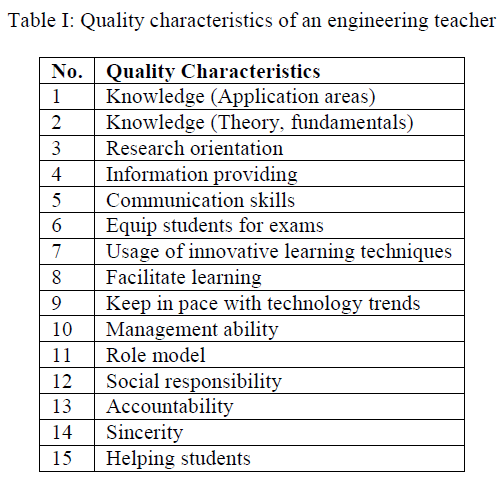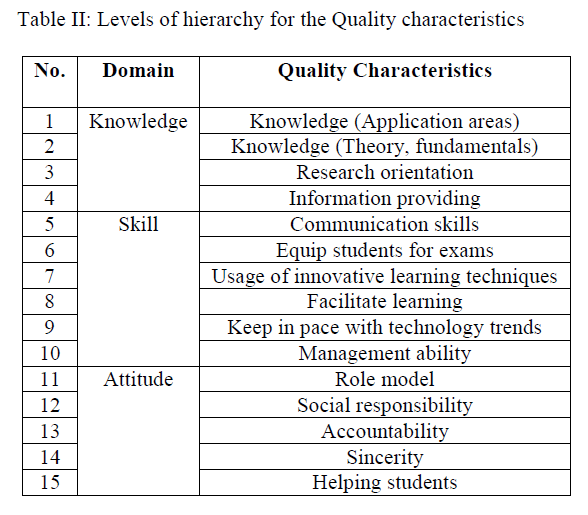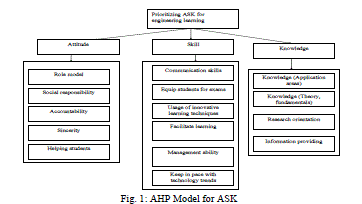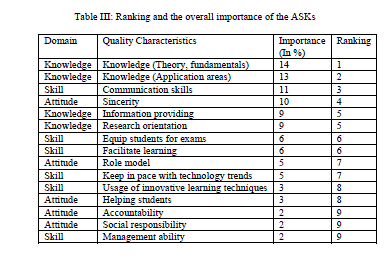ISSN ONLINE(2319-8753)PRINT(2347-6710)
ISSN ONLINE(2319-8753)PRINT(2347-6710)
Sreelekshmy Pillai G.1, Kiron K.R.2, Anoop Kumar G.3, Santhosh Kumar S.4 ,Rajesh Menon B.5
|
| Related article at Pubmed, Scholar Google |
Visit for more related articles at International Journal of Innovative Research in Science, Engineering and Technology
In the current economic conditions, generic skills and professionalism possessed by the graduates are very much essential for them to compete in the turbulent job market. This forces the educational institutions to deliver the best to their customers (students). Teacher quality is rated as one of the most important variable affecting student achievement. Attitude, skill and knowledge of a teacher play a vital role in students. Engineering colleges are different from arts and science colleges with their requirement of skill development. The attributes of a good teacher may be different among the perceptive of teachers. The paper analyses the opinions teachers about the essential quality characteristics of a good engineering college teacher. A survey was conducted among the teachers of the engineering colleges in Kerala who belongs to different disciplines to rate the importance of different attributes. Analytic Hierarchy Process is used for rating the factors.
Keywords |
| Good Teacher; Teacher Quality, Teacher Perception, Analytic Hierarchy Process. |
INTRODUCTION |
| An engineering institution is a complex system that adds value to inputs (students who are admitted into the first year) through a series of interrelated processes (Teaching-learning and supporting processes) using its resources (financial, physical and human) to generate desired outcomes (appropriately trained students) in a given context (regulations related to approval of programmes, admission procedures, examinations, placement opportunities, and economic scenario). The generic skills such as innovativeness, creativity, problem solving ability, and analytical thinking are essential in the process of learning especially in higher education [1]. |
| Fisher [2] pointed that students need to acquire not only the explicit knowledge but also the tacit knowledge. Starfield [3] similarly argues that, other than focusing on mere content of the curriculum, other levels of knowledge, what forms of explanation and argument are allowable and how new knowledge is produced should also be the part of the curricula. In conceptualizing courses, Amos and Quinn [4] consequently mention that less emphasis should be placed on the content and students are required to learn more on the skills needed for coping academically. Scott [5] adds that if the complex student learning difficulties in higher education are to be addressed effectively, it is clear that more attention should be given to academic development work. |
| Learning is a relatively permanent change in knowledge or behaviour that results from practice or experience[6]. Amongst the vast amount of research done under the topic of learning, two of the most prominent theories are those of Skinner‟s [7] operant conditioning and Bandura‟s [8] social learning. According to Skinner [7] operant conditioning is learning that takes place when the learner recognises the connection between behaviour and its consequences. Bandura [8] argues that any attempt to understand how people learn must take into account the impact on learning not only of reinforcement and punishment, but also of a person‟s feelings and thoughts. It should be understood that teachers need not only to master the subject matter, but also to comprehend that the way students learn is a vital ingredient. Special skill from a teacher is required to help students to develop not only their cognitive skills, such as applying; analyzing; synthesizing and evaluating information [9], but also the attitudes such as empathy, caring and support. In addition, all educators should understand the importance of keeping a watching eye with the developments of their field and keeping themselves up-to-date in their areas of specialization [10]. Carpenter had mentioned that successful researchers are also excellent educators. Any scholars who are distinct in the research can succeed in teaching too [11]. |
| Now a day, the teacher quality has become a priority in both government and other educational reform efforts for several reasons. Research findings demonstrate that teacher quality is the single most important school variable affecting student achievement. Well-prepared, highly qualified teachers are essential if we are to ensure that all students achieve the high standards necessary for them to lead fulfilling lives and become productive students. It can also be noted that the studies conducted have established that students change substantially over the course of their undergraduate academic experience[12]. Hence, it is noteworthy to carryout research studies [13] to improve the teaching and learning process, especially of undergraduate education. |
| Many opinions can be observed in the literature about the factors influencing the quality in Indian engineering education. Some of them are teaching process [14], University – Industry collaboration[15], role of management [16], student intelligence & interest[17], excellence of teachers [18], accreditation standards [19], e-education [20] and proper documentation of activities [21]. A committee of colleges, led by Benjamin Bloom, identified three domains of educational activities. Bloom's taxonomy [9] is easily understood and is probably the most widely applied one in use today. Educators often refer to these three domains as ASK (Attitude, Skills and Knowledge). Knowledge plays its role as of foundation, basic building block and also supports the other two – attitude and skills. Skills help in doing things effectively and play a very visible role in dominating over others and becoming competent. Attitude plays a front line role and is a major driver for converting potential energy into Kinetic energy. To Success as a teacher, these three attributes are required. |
II. REQUISITES OF A GOOD TEACHER (FROM LITERATURE ARENA) |
| Various quality characteristics in the context of engineering education are identified through literature review and interaction with engineering teachers of varied backgrounds, and are listed below in Table 1. |
 |
III. METHODOLOGY |
| The data is collected using an interview and questionnaire survey. 64 teachers from various engineering colleges participated in the survey. They were asked to give their perceived importance of each of the quality characteristics in a 1 to 9 scale. The relative importance of these characteristics in the teaching learning process can be found out in a structured way using the multilevel decision making technique Analytic Hierarchy Process (AHP). Intuitively solved decision problems can be solved quantitatively using the procedure-oriented AHP [22]. This technique is very popular due to the fact that the decision maker does not require advanced knowledge of either mathematics or decision analysis to perform the steps of AHP. |
A. Analytic Hierarchy Process(from literature[22]) |
| AHP uses a five-step process to solve decision problems. They are |
| 1. Create a decision hierarchy by breaking down the problem into a hierarchy of decision elements |
| 2. Collect inputs by a pair wise comparison of decision elements |
| 3. Determine whether the input data satisfy a consistency test. If not, go back to Step 2 and redo the pair wise comparisons |
| 4. Calculate the relative weights of the decision elements |
| 5. Aggregate the relative weights to obtain scores and hence rankings for the decision alternatives. |
B. Formation of hierarchy to determine the importance of quality characteristics |
| The decision hierarchy is formulated by breaking down the problem into a hierarchy of decision elements. The topmost level of hierarchy specifies „focus‟ of the study. Intermediate levels correspond to criteria and sub criteria, while the lowest level contains the „decision alternatives‟. For the present study, the focus is „Prioritization of quality characteristics with respect to the importance in teaching learning process‟. There is only one intermediate level, which represents the criteria „Attitude, Skill and Knowledge‟. The last level represents the alternatives, the 15 quality characteristics to be prioritized based on their importance to the teaching learning process. The AHP model is displayed in Figure 1. |
 |
 |
| In the survey, respondents were asked to mark the relative importance of the domains (Attitudes, Skills and Knowledge) with respect to each other in the teaching learning process of an undergraduate engineering programme. Then, they were asked to mark the relative importance of different quality characteristics with respect to each other in assessing the importance of the domain group to which they belong. The individual responses were entered in the positive reciprocal matrix, and the geometric means of these responses were calculated to get the overall group response. The group response was entered to get the judgmental matrix. The individual attention of the researchers to each of the responses at the time of response itself, assured a forced consistency of individual responses. |
IV. RESULT |
| The It has been generally agreed that priorities of criteria can be estimated by finding the principal eigen vector „w‟ of the matrix „A‟. Local priorities of ASK domains as well as the quality characteristics under each domain are calculated. The principle of hierarchic composition by Saaty is utilized to calculate the final priorities of the alternatives. |
| Final priorities = Σi (Local priority of the Quality characteristics i with respect to Domain j |
| * Local priority of Domain j with respect to the importance in the teaching learning process. |
| The ranking and the overall importance of the ASK domains and quality characteristics are displayed in Table 3. |
 |
V. CONCLUSION |
| Teachers participated in the study rated the Attitude, Skill and Knowledge as the indispensable domains of an engineering college teacher. Subject knowledge and communication skills are found to be most important attributes in their view point. A person with relevant knowledge and skills but inappropriate attitude will not be able to contribute much to the organization and the community. Accountability to the teaching profession, management ability and responsibility to the society are less important to them. This is a pathetic situation that „a person having great skills and knowledge and are not socially responsible, they can do greater damage to the organization and society”, which should be investigated to uphold the nobility of the teaching profession. This study focused on the opinion of the teachers, but the opinion of the students may be different from this. |
References |
|